Gabby Tracy, a Holocaust survivor and American citizen, got the shock of her life when she learned that a long-beloved painting on her wall had been looted from Ukraine during World War II. Mikhail N. Panin’s “Secret Departure of Ivan the Terrible Before the Oprichina" had hung in her home for years, undiscovered until late 2017, when Tracy’s bid to sell the painting caught the attention of an art researcher in Virginia. Last month, US authorities filed an official forfeiture notice, with Panin’s priceless work set to return to Ukraine in due course.
The story of the lost painting is one of stolen culture returning to the nest, an omen of sorts for Ukrainian culture under a new occupation. Ukraine’s protracted conflict with Russia is, at its core, one that hinges on issues of identity, where Russia and Ukraine are regarded as one in Moscow. As in every war, art and culture have been forced to the front lines, with Russia persistently suppressing Ukrainian cultural reproduction. In the face of these threats, however, Ukrainian culture is nonetheless alive and thriving.
Fighting over culture and identity
Ukrainian art has quickly become a sphere of conflict with Moscow, not least due to the role it plays in bolstering national identity. “The conflict in Ukraine is a conflict among indigenous communities that have very different ideas of what it means to be Ukrainian,” writes Nicolai N.
Petro of the University of Rhode Island, “It is a war over Ukrainian identity.”
It is in this context that the Ukrainian language, and Ukrainian music with it, has faced an unofficial ban since the outbreak of the conflict more than four years ago. Instead, Ukrainians living in occupied territory have endured the “aggressive propaganda” of Russian culture and way of life, while Ukrainian, Russian and Western political players wrestle with competing visions of Ukraine’s geographical, economic and ethnographic future.
At the same time, Ukrainian art is under pressure from the country’s pro-Russian population, with Russian aggression and cultural appropriation in full swing. “The authorities make artistic practitioners face a choice,” asserts Ukrainian artist Vladimir Kozin in a Stockholm interview, “either you support the politics of Putin, or you are traitors to the nation.” His comments are supported by fellow artist Maria Kulikovskaya, banned from entering the place of her birth, Crimea, and blacklisted by the Russian Federation.
An uphill battle
That Ukrainian media outlets are mostly Russian-owned is further oil in Moscow’s wheels, and leads to the rapid spread of “Ukrainophobic propaganda” with next to no opposition from competing outlets. The bulk of books sold in Ukraine are produced in Russia, with so-called official literature produced in bulk by the state-sponsored Writers’ Union. Union writers enjoy the use of central and regional offices, staff teams, dedicated media channels and summer vacations spent at specially designated resorts. The state-sanctioned writers also enjoy periodic government awards, despite the tenuous reach of their actual output to readers. Independent Ukrainian writers, on the other hand, make do with exactly zero state support.
Private initiatives for survival: Ossipenko and Shafraniuk
Despite these circumstances, however, Ukraine’s art scene in 2019 is still alive – even marching toward a new vibrancy in the ripples of Kiev’s ongoing wrestle with Moscow. That the avant-garde still thrives in a setting of war, corruption and poverty should only be attributed to young Ukrainian artists and activists defying opposition.
Ukraine’s cultural revival is also aided by the support of local entrepreneurs and collectors, who seek to maintain the country as a place for art, notwithstanding the adversarial environment such endeavours face. Businessmen like Serge Ossipenko, for example, are major drivers behind several cultural initiatives.
Ossipenko’s Foundation for Cultural Diplomacy is among the most prolific ones and serves to insert Ukrainian art and culture onto a global stage that is willing to give the support denied thus far from Moscow policymakers, thus preserving Ukraine’s artistic heritage.
At the same time, institutions for art with foreign participation, such as the Ukrainian Canadian Art Foundation, continue to play a vital role in serving Ukrainian culture by preserving, collecting and exhibiting collections of Ukrainian artists or Ukrainian donors. Founded by exiled Ukrainian art collector Mykhailo Shafraniuk in the 1970s, forums like these provide an expanding and safe space in which cultural expression can continue to exist.
Ukraine’s young artists reclaim the artistic sphere
However, there are, of course, other ways in which the arts are making a public comeback. Other means are publications seeking to give a voice to a generation of young people living through the current conflict. The launch of Kiev magazine Golden Coal, for instance, taps into this sense of nihilism and anarchism taking root in a Ukrainian youth culture baptised by war, with artists’ voices bolstered-rather than snuffed out- by the conflict. It is no coincidence, then, that the publication relies on horizontal networks that subvert political divides: it is run from Kiev [VIDEO] but circulated through Ukraine’s sprawling territories, often passed from hand to hand.
Ukrainian art has also come to dominate a different kind of underground world. Last month, a Kiev Metro station made international news when a team of mural artists transformed subway tunnels to commemorate Ukrainian “national unity”. A similar playfulness, with a deliberate political expression, has emerged out of the country’s music scene: “It’s kind of about cleaning your mind,” says Marusia Ionova, a cellist in the capital, “we want our music to be like an injection for people’s minds.”
With 2019 offering scant insight into how the Ukraine-Russian conflict will play out in the coming months, at least one thing is sure: the resilience of the Ukrainian art scene is only a glimpse of what the sector has to offer.



